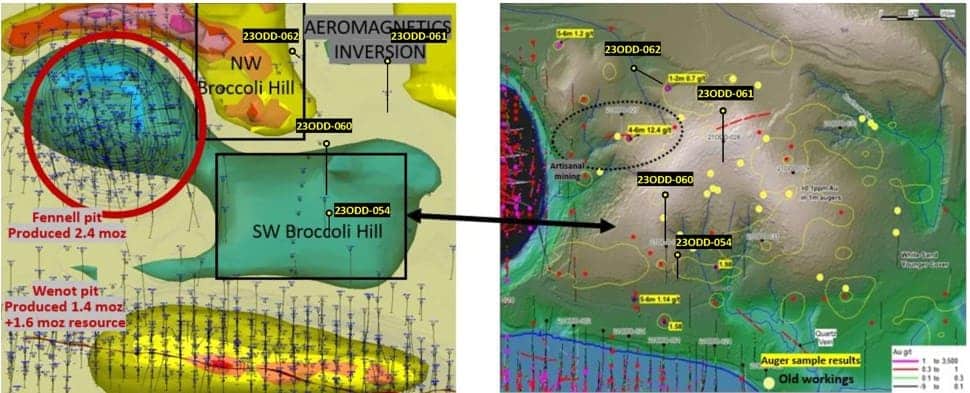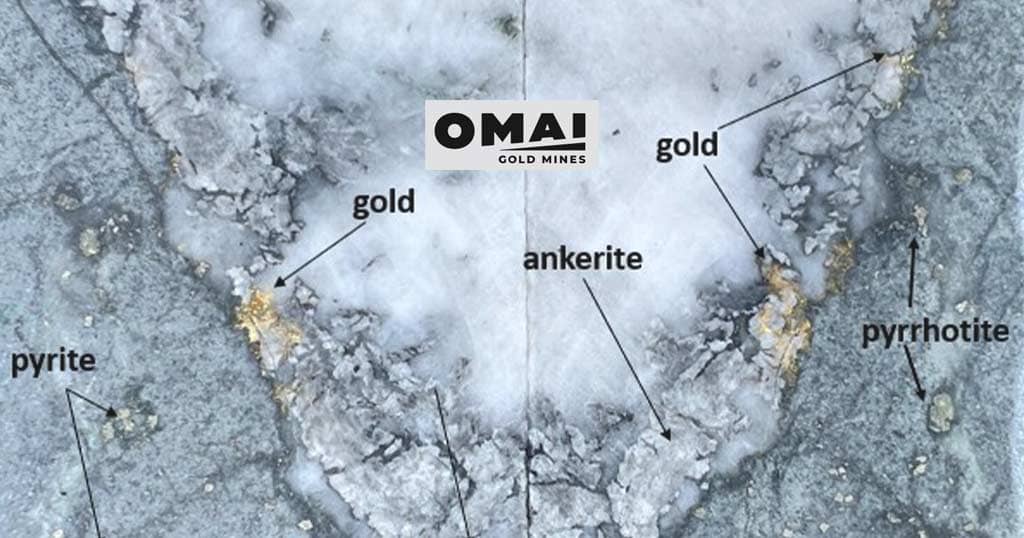Omai Gold Mines Corp. announces additional drill results from the Company’s Omai gold project in Guyana. Assays have been received for five additional holes, including four exploration holes and one hole at Wenot exploring the down dip extension of the central part of the known deposit as well as additional shallower, northern flanking gold zones. To date in 2023, eleven holes have been completed totalling 3,570 metres (“m”) and drilling continues. Hole 23ODD-064 confirms the continuity of the Wenot gold bearing structures to at least 100m below the current resource model in this central part of the deposit with an impressive intersection of 5.18 g/t Au over 20.2 m, including 12.7 g/t Au over 7.9 m. This intercept reinforces growing evidence that the gold grades at Wenot increase with depth.
Highlights for hole 23ODD-064 include:
- 5.18 g/t Au over 20.2 m (including 12.7 g/t Au over 7.9 m)
- 5.86 g/t Au over 13.0 m
- 2.03 g/t over 9.5m
- 1.77 g/t over 9.1 m
Elaine Ellingham, President & CEO, commented, “Similar to our excellent drill results from a couple of weeks ago, these new results again confirm the significant expansion potential for the Wenot deposit, to depth as well as along the flanks. Hole 23ODD-063 results previously released show a very wide 42-75 m zone of gold mineralization at the west end of the deposit, from a 110m to 290 metre depth, with evidence it extends to surface. Hole 23ODD-064 is located 1.25 kilometres east of hole 063, again demonstrating the continuity of the multiple shear-hosted gold zones that extend along a minimum 2.5 km strike.”
“In the first half of the year, we pursued some of the nearby exploration targets and we remain confident that there are additional gold deposits on this well endowed Omai gold property. However, given the large NI 43-101 Mineral Resource Estimate1 established late last year, we believe our drill budget is best focused on: 1) testing some of the undrilled gaps within the Wenot deposit model, 2) expanding the western “starter pit” area, and 3) providing evidence of the blue-sky potential for the Wenot deposit at depth. Results to date are already expected to positively impact the resources as we move forward to an updated mineral resource estimate to be followed by a decision on a preliminary economic assessment (“PEA”) later this year.”
Wenot hole 23ODD-064 intersected multiple zones with gold mineralization (table 1, figure 1), with visible gold identified in 19 locations along the core. The gold mineralization is typical of the Wenot deposit, being hosted within both the quartz veining and the adjacent alteration halos. The veins and vein stockworks typically occur within or at the margins of near-vertical dikes that range in composition from quartz feldspar porphyry to rhyolite to diorite (Photo 1 showing visible gold).
Hole 064 is located in the mid-region of the Wenot deposit where there was a 200-metre gap between drill holes 21ODD-001 and 21ODD-024 (figure 2, table 2). Drilling indicates that the Wenot shear corridor in this area is at least 400 metres in width. Hole 23ODD-064 was 713 m in length and most of the gold mineralization was within the volcanic rocks on the northern side of the central contact shear. The hole ended within intensely sheared sedimentary rocks, still within the Wenot shear sequence. Unfortunately, given the significant width of the shear, it is difficult to drill across the full width with a single drill hole at the targeted depths, so there are quite possibly additional zones within the southern sedimentary rocks that remain to be tested.
The nearest holes to 23ODD-064 are 21ODD-001 and 21ODD-013 located 100 m to the west and 21ODD-024 drilled 100 m to the east. The gold zones correlate well and the zone in hole -064 of 5.18 g/t Au over 20.2 m at the central contact shear within the quartz feldspar porphyry dike and adjacent protomylonite correlates with the same zone within hole -001 of 4.77 g/t Au over 22m and in hole -013 of 6.92 g/t Au over 19m.
| From | To | Gold g/t | metres | |
| 23ODD-059 | no significant results | |||
| 23ODD-060 | 55.5 | 57.0 | 5.63 | 1.5 |
| 23ODD-061 | 110.0 | 110.3 | 7.16 | 0.3 |
| 155.9 | 156.9 | 0.35 | 1.0 | |
| 255.4 | 258.8 | 0.35 | 3.4 | |
| 23ODD-062 | no significant results | |||
| 23ODD-064 | 239.0 | 240.3 | 3.92 | 1.3 |
| 255.0 | 262.5 | 0.67 | 7.5 | |
| 288.3 | 289.5 | 0.70 | 1.2 | |
| 294.9 | 298.2 | 1.44 | 3.3 | |
| 365.7 | 369.0 | 1.97 | 3.3 | |
| 404.0 | 409.0 | 0.49 | 5.0 | |
| 466.0 | 475.5 | 2.03 | 9.5 | |
| 489.0 | 502.0 | 5.86 | 13.0 | |
| 506.0 | 508.0 | 2.68 | 2.0 | |
| 512.5 | 515.0 | 3.72 | 2.5 | |
| 557.6 | 566.7 | 1.77 | 9.1 | |
| 655.0 | 675.2 | 5.18 | 20.2 | |
| includes | 667.3 | 675.2 | 12.70 | 7.9 |
*True widths vary as mineralization at Wenot is generally hosted within stockwork vein systems with alteration halos, with an estimated true width range of 70-90%. Cut off grade 0.30 g/t Au with maximum 4m internal dilution.
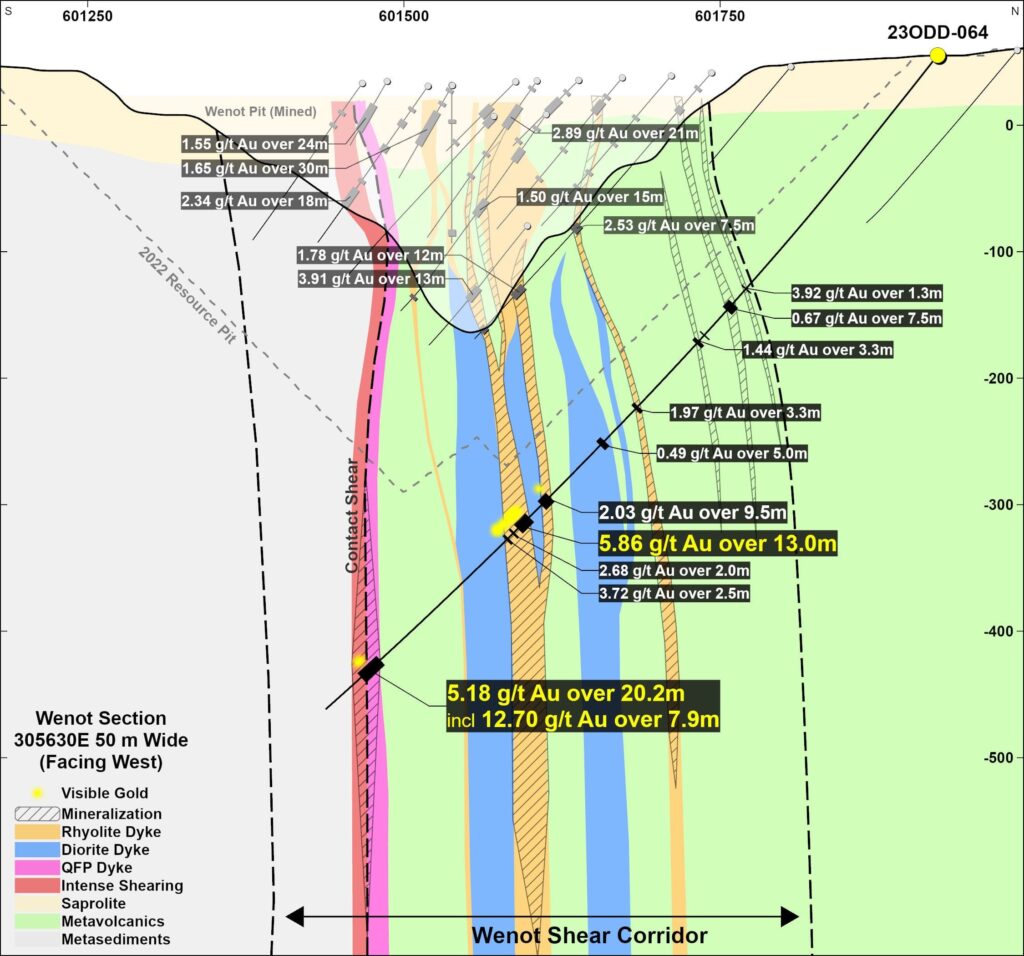
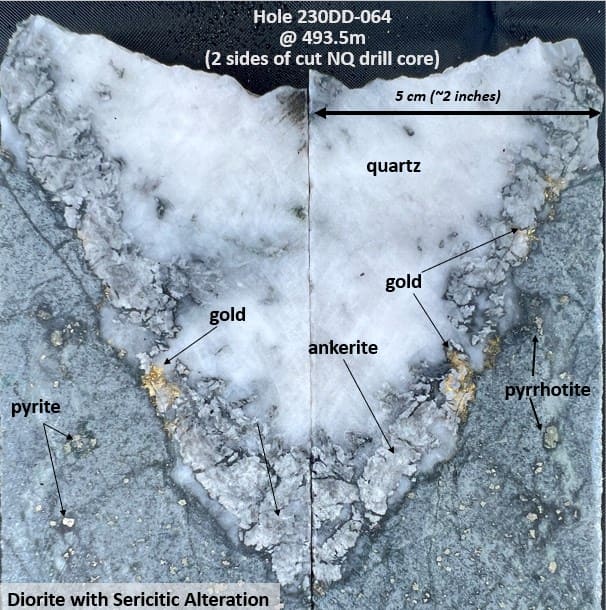
The favourable higher grade and wider gold zones identified in holes 23ODD-063 and 12ODD-064 can be expected to positively contribute to the next updated Mineral Resource Estimate for Wenot, planned after the completion of this current drill program. The most recent NI 43-101 Mineral Resource Estimate for the Omai property, dated December 2, 20221 includes a Wenot resource of 756,600 indicated ounces of gold grading 1.34 g/t Au and 1,112,600 inferred ounces of gold grading 1.72 g/t Au. For the adjacent Gilt Creek deposit, the NI 43-101 Mineral Resource Estimate is 1,151,000 indicated ounces of gold grading 3.22 g/t Au and 665,000 inferred ounces of gold grading 3.35 g/t Au.
Assay results from an additional four exploration holes have been received. Hole 23ODD-059 tested the very west end of the Boneyard magnetic low anomaly and also a possible splay from the eastern end of the Wenot deposit (figure 2). Although brecciated volcanics with silicification and alteration were encountered, no anomalous gold was returned. Further drilling of the main target at Boneyard is impeded by a covering of liquified sand behaving as quicksand and further field work will be required to identify safe drill sites that will properly test the target.
Two holes on Broccoli Hill, in addition to 23ODD-054 drilled earlier this year, tested a 580 metre north-south fence along the central portion of a targeted magnetic anomaly that appears similar to the magnetic signature of the adjacent Gilt Creek intrusion-hosted gold deposit (figure 3). Holes 23ODD-060 and 061 intersected mostly basaltic volcanics with strong propylitic alteration and a 12m interval of lithic tuffaceous rock, similar to the sequence encountered in 23ODD-054. A number of narrow gold-bearing quartz veinlets were intersected that assayed 5.63 g/t Au over 1.5m, 7.16 g/t Au over 0.3 m and 0.35 g/t Au over 1.0 m. No clear explanation for the magnetic low was observed and given the very large size of Broccoli Hill, and the extent of geochemical indicators and historical artisanal mining, these three holes do not adequately test the potential of the area.
A single hole 23ODD-062 tested the Brother gold target located NE of the Gilt Creek deposit and on the northwestern side of Broccoli Hill (figure 3). Trenching in 2021 exposed a package of narrow high grade gold veins and veinlets assaying 29.3 g/t Au, 7.8 g/t Au, 5.0 g/t Au and 2.2 g/t Au along a 40-metre strike. Two short drill holes were completed in late 2021, with one hole intersecting 1.3 g/t Au over 1.5m and a second hole intersecting 0.91 g/t Au over 6.8 m and 2.4 g/t Au over 1.5m, all providing further encouragement for additional exploration in this area. Hole 23ODD-062 tested the northeastern extension of this with no signficant gold encountered.
An additional hole (23ODD-065) was recently completed in the western area of Wenot with sampling underway and hole 23ODD-066 has commenced, designed to test the underexplored sediment-hosted zones on the south side of the Wenot shear contact. At the western end of the Wenot deposit, the sediment-hosted zones extend to surface are proving to be quite wide with good grades, and these zones were not previously exploited.
An unusually high volume of trading in the Company’s stock late last week resulted in downward pressure in the stock price. The Company is not aware of any negative news or developments that would account for this. The Company has a cash position of over $2 million, sufficient to complete the planned drilling and the updated mineral resource planned for later this year. Our plan is to consider proceeding with a PEA immediately thereafter.
Quality Control
Omai maintains an internal QA/QC program to ensure sampling and analysis of all exploration work is conducted in accordance with best practices. Certified reference materials, blanks and duplicates are entered at regular intervals. Samples are sealed in plastic bags.
Samples from the Wenot drilling were shipped to ActLabs, a certified laboratory in Georgetown Guyana, respecting the best chain of custody practices. At the laboratory, samples are dried, crushed up to 80% passing 2 mm, riffle split (250 g), and pulverized to 95% passing 105 μm, including cleaner sand. Fifty grams of pulverized material is then fire assayed by atomic absorption spectrophotometry (AA). Initial assays with results above 3.0 ppm gold are re-assayed using a gravimetric finish. For samples with visible gold where initial assays do not run above 3 g/t, a second pulp is made from the coarse reject and an additional fire assay completed. Certified reference materials and blanks meet with QA/QC specifications. Certain samples with potential or evidence of coarse gold were selectively analysed at ActLabs by Metallic Screening whereby a representative 500-gram sample split is sieved at 149μm, with assays performed on the entire +149 μm fraction and two splits of the -149 μm fraction. When assays have been completed on the coarse and fine portions of the large sample, a final assay is calculated based on the weight of each fraction.
Qualified Person
Elaine Ellingham is a Qualified Person (QP) under National Instrument 43-101 “Standards of Disclosure for Mineral Projects” and has approved the technical information contained in this news release. Ms. Ellingham is not considered to be independent for the purposes of National Instrument 43-101.
1 The Company filed an NI43-101 technical report titled “Technical Report and Updated Mineral Resource Estimate of the Omai Gold Property, Potaro Mining District No. 2, Guyana”, prepared by P&E Mining Consultants Inc dated December 2, 2022 on the SEDAR website www.sedar.com.
ABOUT OMAI GOLD
Omai Gold Mines Corp. holds a 100% interest in the Omai Prospecting License that includes the past producing Omai gold mine in Guyana, and a 100% interest in the adjoining Eastern Flats Mining Permits. The Company announced an updated Mineral Resource Estimate (“MRE”) October 20, 2022 that includes a 14% expansion to the Wenot shear-hosted gold deposit and an initial NI 43-101 MRE for the adjacent Gilt Creek intrusion-hosted deposit. Once South America’s largest producing gold mine, Omai produced over 3.7 million ounces of gold between 1993 and 2005. Mining ceased at a time when the average gold price was less than US$400 per ounce. As a brownfields project, Omai benefits from good access and a wealth of historical data that provides knowledge of the geology, nature of the gold mineralization on the property, as well as metallurgy and historical recoveries. The Company’s priorities for 2023 are to drill the key exploration targets that hold potential for significant new discoveries while continuing to expand the Wenot deposit in anticipation of an updated resource later this year.
For further information, please see our website www.omaigoldmines.com or contact:
Elaine Ellingham P.Geo.
President & CEO
[email protected]
Phone: +1 416-473-5351
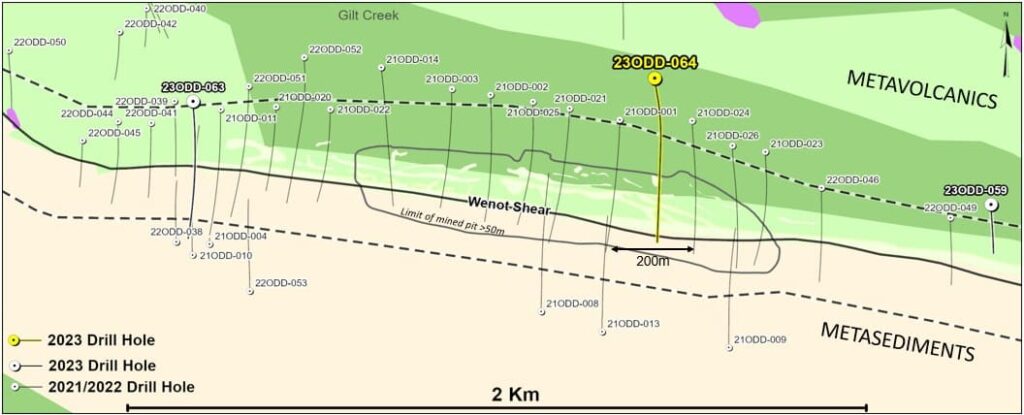
| Hole ID | Azimuth (degrees) | Inclination (degrees) | Final Depth (m) | Easting | Northing |
| 23ODD-059 | 180 | -50 | 212 | 306540 | 601572 |
| 23ODD-060 | 180 | -50 | 290 | 305544 | 602358 |
| 23ODD-061 | 180 | -50 | 302 | 305765 | 602640 |
| 23ODD-062 | 140 | -55 | 134 | 305446 | 602769 |
| 23ODD-064 | 174 | -52 | 713 | 305629 | 601922 |
